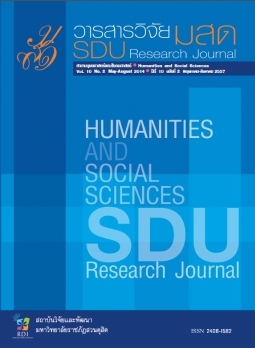Evaluation of the Bachelor of Nursing Science Program, Faculty of Nursing, Suan Dusit University, in Academic Year 2015 (Revised edition B.E. 2555)
Keywords:
Curriculum evaluation, Bachelor of Nursing Science ProgramAbstract
This study aimed to evaluate the Bachelor of Nursing Science Program
(Revised edition B.E. 2555) of Faculty of Nursing, Suan Dusit University, in
Academic Year 2015 by CIPP Model. The sample was 431 participants who were 10 administrators of health centers, 45 instructors and 376 nursing students from Year 1 to Year 4. A research instrument was a questionnaire which asked for
five sets of questions: 1) a set of questions for a seminar of graduate employers
regarding graduates’ qualifications, 2) a context assessment of the curriculum,
3) an input assessment, 4) a process assessment of curriculum implementation and 5) an output assessment. Data was analyzed by frequency, percentage, mean and standard deviation. Findings were as follows. First, a context assessment of the Bachelor of Nursing Science Program (Revised edition B.E. 2555) of Faculty of Nursing, Suan Dusit University, found that graduates’ qualifications according to all six learning outcomes specified by Thailand Qualification Framework (TQF) reached a good level. The appropriateness of curriculum philosophy and objectives earned the highest average score ( = 4.59-4.65). Second, an input assessment found that a curriculum structure had a high mean score ( = 4.41-4.72). An average score of teaching facilities was at a moderate to high level ( = 3.19-3.62). An assessment of building and learning facilities had a high mean score ( = 3.87-4.08) while other services provided by relevant units had a moderate to high average score ( = 3.083.61). Additionally, an input assessment regarding instructors found that 75% of lecturers earned a master’s degree qualification and had teaching experience for 10 years and above. Students chose to study nursing science program because of
employment after graduation while 75% of students had financial support from a government’s Student Loan Fund. Third, a process assessment revealed that
teaching and curriculum management had a high average score ( = 4.43). Fourth, regarding learning achievement as an output assessment, 91.09% of nursing students had accumulated grade point average (GPAs) between 2.50-3.00. They also
represented nursing student and graduate competencies specified by Thailand’s TQF at a high level ( = 4.40).
References
Educational Science STOU, 8(1), 16-28. Ruongrung, P. el al. (2014). Educational Technology with Thai Teacher in 21st Century. Panyapiwat Journal, 5, 195205. Stufflebeam, D.L. & Shinkfield, A.J. (1990). Systemic Evaluation. Boston: Kluwer-Nijhof.
Suwit, B. et al. (2014). An Evaluation of the Bachelor of
Nursing Curriculum (Revised Edition 2012). Kuakarun Faculty of Nursing, Navamindradhiraj. Kuakarun Journal of Nursing, 22(2), 71-90. Thailand Nursing and Midwifery Council. (2010). Manual of Accreditation Nursing Education. Bangkok: Thailand Nursing and Midwifery Council.
Tyler. (1969). Basic Principles of Curriculum and Instruction. Chicago: The University of Chicago Press. Wongyai, W. (2011) The Curriculum Development in Higher Education. 12th ed. Bangkok: R and Print.








